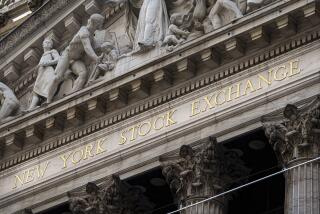Bonds mostly in the red
- Share via
Normally, losing 5% in a bond mutual fund in a quarter would be considered a terrible performance.
But with double-digit stock market losses so widespread in the three months ended Sept. 30, the bond market’s red ink seemed much easier to bear.
That story line has continued in spades in the fourth quarter, just 12 days old. Many bond funds again are in the red, but far less so than stocks, which have been brutalized by relentless selling.
In both markets, the central issue remains investors’ desperate desire to reduce risk and focus on safety of principal, amid severe worries about the financial system and economy.
For a few days at the end of the last quarter, even a classic risk-reduction move -- shifting savings to money market mutual funds -- appeared to be fraught with peril after a large money fund lost principal value on IOUs of bankrupt brokerage Lehman Bros. Holdings Inc.
The revelation triggered a run on many other funds, until the U.S. Treasury stepped in with a temporary insurance plan to guarantee money fund investors’ principal. With the global credit crunch worsening, the last thing Wall Street needed was a sustained run on the $3.3-trillion money fund business.
The credit crunch also has had a direct effect on investors’ perceptions of bond values, of course. Junk bonds, for example, have plunged in value because investors assume that it will only get more difficult for debt-heavy companies to fund themselves. That boosts the risk of default on junk issues.
Overall, though, the advantage bond funds have over stock funds in dicey periods like this is that the interest income bonds provide is a cushion against loss of principal value. That makes bonds a relative haven in a diversified investment portfolio.
Here’s a look at how various bond fund categories fared in the third quarter:
Government bond funds
The government category was the only winner in the quarter, as investors worldwide hoarded Treasuries as a safety play.
The average fund that owns longer-term government bonds rose 1.4% in the three months through Sept. 30, according to Morningstar Inc. That’s a “total return,” meaning interest earnings plus or minus principal change.
The yield on the 30-year Treasury bond slid from 4.52% at the end of June to 4.31% at the end of September, boosting the value of older bonds issued at higher yields.
Funds that own intermediate-term and short-term government bonds also recorded positive returns in the quarter, although they were modest.
Still, last week’s rebound in long-term Treasury yields was a reminder that it is possible to lose money even in government bond funds: If market rates rise, older bonds issued at lower yields are devalued.
With yields so relatively low on Treasuries now, some analysts warn that long-term returns on government bond funds could be disappointing. “You’re buying a very expensive asset” at current prices, said Jeff Tjornehoj, a fund industry analyst at Lipper Inc.
Some money managers say government-backed mortgage debt, such as bonds backed by Ginnie Mae, are a much better investment than Treasuries.
“At current yields, we believe this sector represents some of the best value available for investors,” investment strategists at money management giant BlackRock Inc. told clients in a report last week.
Corporate bond funds
This sector suffered sharp losses in the quarter as nervous investors shunned even the highest-quality corporate debt. That drove up market yields and drove down bond values.
Generally, the shorter the maturity, the smaller the loss on corporates in the three months -- which is the way it’s supposed to work.
Morningstar’s intermediate-term investment grade bond fund category lost 3.6% in the quarter, while the long-term investment grade category fell 7.2%. A loss on a bond fund means the decline in the fund’s share price more than offset interest earnings.
Within the corporate bond sector, junk bond funds were slammed in the quarter, losing 8.2% on average. Things got worse last week as worries about the economic fallout from the credit crunch triggered another heavy wave of selling of junk securities.
Investors also have continued to dump bank loan funds, which buy pieces of corporate loans. Those funds slumped 6.8% in the quarter.
Analysts figured that default rates on junk bonds would rise as the economy weakened. But the scope of the credit crunch now has many on Wall Street fearful of the worst recession since the early 1980s, and expecting a much larger number of bond defaults than was estimated even a few months ago.
“The unprecedented crisis gripping the financial sector will magnify default risk, causing this cycle to be significantly deeper and more dispersed” across industries, analysts at Standard & Poor’s warned in a recent report.
On Friday, the average yield on an index of 100 junk issues tracked by KDP Investment Advisors soared to a 17-year high of 15.62%, up from 10.85% in mid-September and 10.23% at the end of June.
So investors are demanding extraordinary yields to buy junk securities. The risk is that, even at these yields, it won’t be enough to compensate for bonds that go belly up.
Foreign bond funds
The world bond category, which includes funds that own foreign government bonds, lost 4.9% in the quarter. The main culprit: a sharp rise in the dollar, which devalued securities denominated in foreign currencies.
Emerging-market bond funds sank 7.1% in the quarter on average. These funds were the bond market’s stars of the last five years. But they gave back a chunk of their long-term gains in tandem with the deep sell-off in emerging-market stocks in the quarter, as some investors fled for traditional havens such as U.S. government securities.
The strong dollar also hurt emerging-market bond funds. The Brazilian real, for example, suffered a 19% depreciation against the dollar in the quarter.
Many analysts remain optimistic about emerging market economies for the long run. But investors may continue to shy away from the sector’s bonds until it’s clearer how big a hit those economies will take if the U.S. and Europe are tumbling into recession.
Municipal bond funds
States, cities and other municipal entities are facing a double whammy from the credit crunch. Their tax revenues are threatened as the economy weakens. At the same time, most have been shut out from borrowing in recent weeks as investors have shunned all but U.S. government securities.
That has pushed muni bond yields sharply higher and devalued older bonds.
The average fund that owns long-term California municipal bonds lost 4.8% in the quarter and was down 5.9% year to date.
Still, for investors in upper tax brackets, tax-free yields on municipal bonds may be too tempting to pass up now, analysts say. The yield on 10-year California general obligation bonds was about 4.87% on Friday, up from 4.25% on Sept. 1.
A 4.87% tax-free yield is worth the equivalent of a fully taxable yield of 7.46% for a Californian in the combined 34.7% federal and state marginal tax bracket (which begins at joint taxable income of $131,000).
But one challenge facing the muni market is that it is a prime victim of the deleveraging occurring in financial markets.
Hedge funds and other big investors that bought munis using borrowed money have been forced to dump securities to pay off that debt.
“It’s not clear if we’ve yet seen all of the effects of that unwinding,” said Eric Jacobson, bond fund analyst at Morningstar in Chicago.
What’s more, a huge backlog of muni bond issues is waiting to come to market, which could put more upward pressure on yields in the next few months.
“I think investors need to be flexible for opportunities” that will arise in the muni market soon, said Matt Fabian, senior analyst at Municipal Market Advisors in Westport, Conn.
--
More to Read
Inside the business of entertainment
The Wide Shot brings you news, analysis and insights on everything from streaming wars to production — and what it all means for the future.
You may occasionally receive promotional content from the Los Angeles Times.










